Search: Attacking Narrow Channel
Attacking narrow channel
A good exercise for scanning defenders and creating space for your co attackers
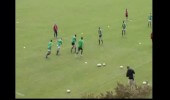 0:48
0:48
Lions - Attacking channells
From the Lions 2009 tour, a support drill in a channel to encourage the ball carrier to move the defender and make space for the support player
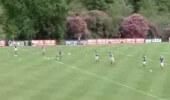 0:23
0:23
British lions - support & attack drill 1
This drill illustrates how attack can go from narrow channels to wide play very quickly, and players should practice this continually
To watch over 2500+ videos join now for free!
JOIN NOWL2 - Identifying Space to Attack
Skill Practice Description • Attacking team face away from defenders before play commences. • Attackers spread or grouped in any formation. • Defenders split (unseen by attack) between pitch A & B. • Coach calls “turn” and introduces the ball to the attack who turn to scan the distribution of the defence and attack whichever pitch they choose. • Defenders on the pitch not being attacked cannot cross over to help defend. • If the attack breaks down, the defence gain bonus point. • If attackers choose to attack the area with the most defenders and still score - gain a bonus point. • Progression: • Allow the defenders in the area not being attacked to move across to support the other defence. Perhaps make the secondary defence go deeper around a cone. • Vary the space before game starts between attack and defence - more or less time for the attackers. • Allow defence to recover the ball to counter attack. Key Coaching Points • Reward close and immediate support of the ball carrier in and around contact area. • Defenders deny space and time to the numerically superior attack
QBE - Identifying Space to Attack
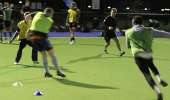 2:40
2:40
Two Channel Passing Exercise
Players work in 3s running around the corner and realigning to attack. Introduce defenders and the need to look up and communicate.
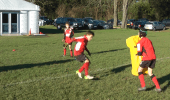 1:04
1:04
Tackle Technique in channel
Use a channel with attackers and defenders to progress the tackle technique, mix the players up so they all have opportunities. Reinforce the coaching points and give praise regularly
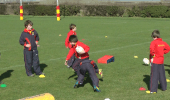 2:24
2:24
1 v 1 Tackling in Channel
An opportunity for players to put what they have learnt on tackle technique into practice. Each tackle is observed by all other players who can give feedback. Ensure all players have a go at attacking and defending.
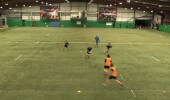 0:34
0:34
3v2 in Channel
A simple yet effective drill that enables players to test out their attacking options. They must attempt to control the situation by committing one defender, to create the 2v1.
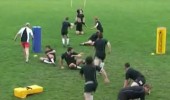 0:11
0:11
Offload out of the tackle in channel
A good start for developing offload and tackle skills, allowing you to manage the amount of contact in the tackle whilst performing the skill successfully. Key factors : Strong base - Lead with arm and shoulder - Keep looking forward with head up - Wrap arm around legs / waist and squeeze tight with other arm - Use attackers bodyweight to rotate your body
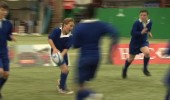 0:26
0:26
3 v 2 in Channel
A development of the 2 v 1 and 3 v1 drills, the attackers now must beat 2 defenders. This requires more decision-making ability as the movements of the defenders could change every time. Players must communicate as well as continue to perform their handling and running skills.
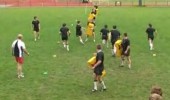 0:12
0:12
Draw the defender and support in channel
The key to creating space is to move a defender away from the space, this drill allows the ball carrier to create the space and the support runner to attack the space
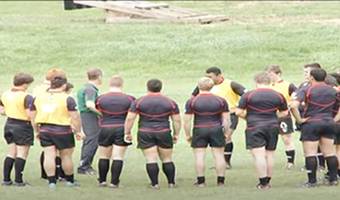 2:16
2:16
L2 - Outflanking Game
Skill Practice Description The objective of this game is to develop the ability to execute the 2 v 1 with consistent efficiency. • The attacking team initially has at least one extra players in order to create an advantage. • There is a channel on each wing in which only 1 defender and 2 attackers may enter at any time. • The attack works the play to get the ball into the outside channel then execute the 2 v 1. • With the extra players, the attack can also develop opportunities to penetrate the defence and so the game in not relying on lateral moment and still incorporates the principles of ‘go forward’. • The progression is to remove the cones and see if the players can still take advantage of the 2 v 1 without the conditions set within the channelled areas . • A further progression would be to even the numbers of each team. Key Coaching Points • Running lines to condense and hold defences in order to outflank. • Running lines in order to disrupt and penetrate the defence line. Relevance to the Game • Attacking players often fail to fix defenders effectively and may drift or over elaborate. • This game will assist in angles of run that fix the last defender
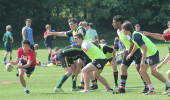 1:29
1:29
Saints - Attacking Basics
Northampton Saints coaches look at the basic principles of attack including holding depth and scanning the defensive situation.
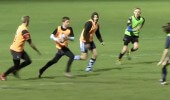 5:23
5:23
Passing and Attacking Lines
Northampton Saints Academy coaches introduce a conditioned exercise to help develop attacking skills.
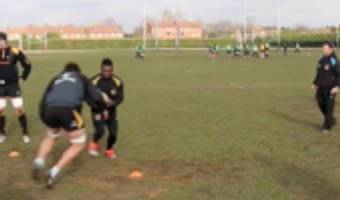 1:33
1:33
Scrum Factory - 11. Flanker Channeling and The Role of the Number 8
The roles of each player in channelling the ball to the number 8
 3:21
3:21
Three Channel Passing Challenge
Adding pressure to key skills is crucial to improve your players and to practise like you play. This exercise covers a variety of skills but essentially is about accurate passing and fixing defenders
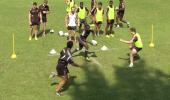 6:17
6:17
Quins - Attacking lines of support
Harlequins academy players are coached to be accurate in their passing and use lines of running and footwork to create space for other players
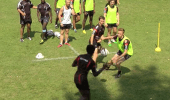 5:59
5:59
Quins - Creating Space & attacking lines
This clip shows the principles of fixing defenders and the techniques used to do so. The coach can progress by using more defenders, varying the space or changing the source of where the ball comes from
L2 - Attacking a Drift, Blitz and Cover Defence
Skill Practice Description • Within a game of touch the coach can at any breakdown - call blitz, drift and the defenders must run and touch the appropriate line. • The coach may also give players numbers in order to call specific defenders to leave the defence line which will create the need for defence to realign quickly. • Attackers must face the other way and attack when the ball is rolled from behind them. • On the coach’s call, the attack turn and the closest attacker picks up the ball and plays. • This ensures the coach can vary each player’s role and make the defence react. • Coach can then develop game by giving a visual clue to the defenders thus making the attackers react to an unexpected type of defence. Key Coaching Points • Visual Acuity-Looking for space. • Spatial awareness. • Highlighting defensive systems and attacking them appropriately. • Decision making. Relevance to the Game • This game is excellent for visual acuity and attacking differing defensive alignments. • Spaces are created by the leaving defenders, which the attackers have to identify
Back Play - Attack From Line Out - Older Youth
To take advantage of the forwards being grouped and to utilize the space this provides, the appropriate strike call needs to be made and space attacked
It’s not a matter of going through the strike move repertoire. It is about specific selection from the repertoire in order to attack identified areas of the opposition and game situations
Attacking the space between the two teams is paramount and attacking the ball when running a support line will assist the offload and turn defenders
Back Play - Attack From Scrum - Older Youth
It’s not a matter of going through a strike move repertoire. It is more about specific selection from the repertoire in order to attack identified targets according to the opposition and game situation
Attacking the space between the two teams is paramount and attacking the ball when running a support line will assist the offload and turn defenders
L2 - Back Line Attack from Set Piece
Skill Practice Description • The objective of this game is to score from first phase. • The defence start on the try line and can only advance to the five metre line (gain line). • The attack must start from the 5 metre line if simulating a scrum and vary the starting points i.e. centre field. • If simulating a lineout start, use the 10 metre line to half way. • If the attack can score from the set piece they are awarded five points. • If they score after one phase they are awarded four points. • If they score after two phases they get awarded three points and so on. • If the attack fails to score after four phases they turn around and defend. • Kicking options may be introduced. • Five attacks each team. Key Coaching Points • Appropriate passing (short, long, flat, deep etc.) • Appropriate running lines; decoy / option / creating spaces / accelerating into space. • Support and reaction. • Look-Think -Do Process • Allow the players to self correct before intervention from the coach Relevance to the Game • Accuracy in decision making scanning and decoy / option running lines
L2 - Attacking a Condensed Defence
Skill Practice Description • Two teams play normal touch rules. • 5 touch turnover. • When a touch is made, the game pauses and all defenders need to close in and place a hand on the shoulder of another defender. So all the defenders are bunched and in contact with each other. • The coach calls ‘play’ and the attack restarts. • The progression may be to leave one defender out of the bunch, which may provide a different challenge to the attack. • Then leave two defenders out of the bunch and slowly release the conditions to see if the attack can consistently identify opportunities to outflank or penetrate the defence. Key Coaching Points • Peripheral vision and general awareness. • Intuitive decision making. • Communication • Support and team work. Relevance to the Game • This game is designed to challenge the observation and decision making ability of the attack. • For the defence, it challenges the ability to cover quickly with both drift and sweeping defenders
L2 - Fly Half Development
Skill Practice Description • Two channels each 15metres wide • Two attacking lines of four players; one line in each channel • Scrum Half with two balls • Three defenders lined up to defend the designated channel. • SH passes ball to 1st attacking group on the coach’s call. • D1 goes for A1, D2 for A2, D3 for A3 • Attackers to fix defenders and release overlap. • Coach shouts “Break” and the three defenders run to defend the other channel against 2nd group of attackers. • On coach’s command “Go” the 2nd ball is passed to the second line • Rotate the groups and alternate which channel has the first strike / second strike • Vary the timing of the second call which releases the ball for the 2nd strike. An early call frees up space for the fly half because the defenders will have little time to get into the second channel. A late call, allows defenders time to get across, and it means the fly half will have to prevent the drift and effectively use the overlap. • Initially the coach can control the defence telling the defenders to leave the overlap and be fixed; then allow them to drift, then allow them to try anything to stop the attack. Here is also an opportunity to coach how to defend. Key Coaching Points • Stay square - outside shoulder should be seen by scrum half • Run at defenders aiming at the inside shoulder • Move when the ball is in the scrum half’s hands or when it is in the air. Do not creep forward before then.
Back Play from Set Piece - Attack from Line Out
To take advantage of the forwards being grouped and to utilize the space this provides, the appropriate strike call needs to be made and space attached.
Attacking the space between the two teams is paramount and attacking the ball when running support lines will assist the offload and turn defenders.
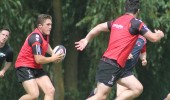 2:15
2:15
Quick fire Attacking Game
This is a great game to keep players engaged by constantly testing their decision-making and execution in attack. Essentially, it's a 4 v 2 game where the attackers always have the advtantage, but they still have to make good decisions to score. It is a high-tempo game that requires the attackers to turn around and attack again straight after scoring.
Back Play from Set Piece - Attack from Scrum
It’s not a matter of going through the strike move repertoire. It is about selecting appropriately from the repertoire according to the opposition and game situation.
Attacking the space between the two teams is paramount and attacking the ball when running support lines will assist the offload and turn defenders.
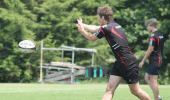 4:17
4:17
Attacking Ability at 13
Outside centres who have great attacking awareness and distribution skills are integral to teams who like to exploit quick ball by going wide. If these players are only able to run hard lines, then there are going to be missed opportunities out wide. Here, we highlight some great passing and attack play in the Premiership, as well as some ideas for you to use with your players.
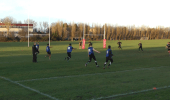 0:59
0:59
Broncos 6 - Attack to Defence 8 v 5
A combination of skills are tested, both technical and tactical with the defenders moving from a passing activity to defending 8 attackers. The coach can change the attack with different starting points and number of attackers
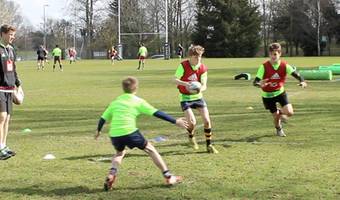 3:21
3:21
Identify Attacking Options
A few drills that will help the attackers identify space in attack and work on how to exploit it!
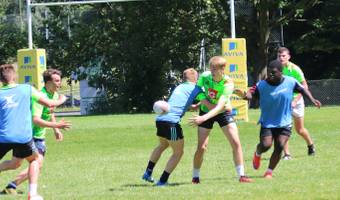 2:27
2:27
Small-side game - Overload Attack
The attacking team always has two or three extra players and the attack need to make best use of this numerical advantage. The coach can put three players in a different colour and they swap teams after each score to remain in the attack.
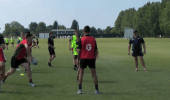 6:36
6:36
Attacking lines and late shifting
This clip demonstrates the skills and movements required to fix and beat defenders. Using a combination of passing accuracy and physical agility can significantly improve your attacking options. The coach uses questions to help the players learn
L2 - Penetrating Defence Game
Skill Practice Description • The playing area is marked out in 5m channels. • When defending, players must stay within their channel throughout the game. • The attack must look to penetrate the defence by creating and preserving space. • The defence must use a two handed touch. • There is a 5 tackle turnover rule and once possession is turned over, the defence must get into a channel as the opposition can attack immediately. Key Coaching Points • Support players to hold their opposite number as long as possible before cutting a line to take the pass. • The defender can close the space as far as the edge of their own channel. • If the support player cuts too early or the ball carrier does not move their defender enough, the support player will be touched/tackled. Relevance to the Game • This game will help develop the footwork and running lines to effectively move defenders in order to penetrate the tackle line.
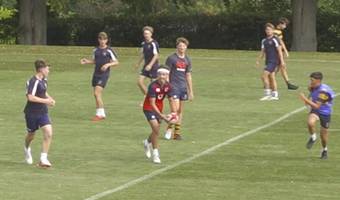 3:39
3:39
Overload Attack Game
This game allows your attack to experiment whilst working on communication, reloading for depth and handling skills. With an attacking overload this will also work on your defence communication and organisation in phase play.
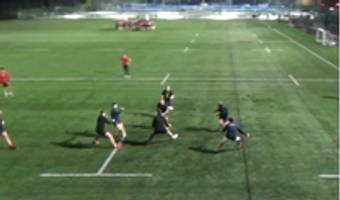 1:28
1:28
Attack vs Defence Continuous Drill 4V2
The attackers work to beat the defence, setting up a 'tip' (running a hard line) and 'pull back' option. They should read the defensive movements and make a decision to hit the tip option or pull out the back.
QBE - Attacking a Drift, Blitz and Cover Defence
QBE - Attacking a Drift, Blitz and Cover Defence
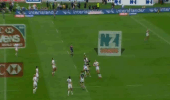 0:28
0:28
Sevens - Standard restart with attack winning ball 3
A well organised re start with one main attacker challenging for the ball with support both in front and behind him, if the ball is knocked either side of the main catcher the ball will be gathered by his teammates. Great leg drive to continue the attack and a very long pass to complete the scoring. Key factors : Accurate kick - Focus on the ball - Sideways jump - Catch ball above head - Structured support
 0:54
0:54
Attacking progression's 5 v 4
Progressing from 3 v 2s an 4 v 3s, you can now attack with something resembling a full back-line. Give the defence different instructions each time to test the reactions and decision-making skills of your attacking players.
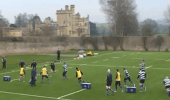 1:00
1:00
Attack and Re-align
Players are required to continually attack the gain-line, and re-align after each effort. They should try to use their inventory of attacking methods, not randomly, but to control the defence to eventually create gaps to exploit.
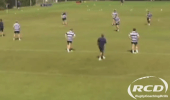 0:51
0:51
Attacking progression's 4 v 3
A progression from 3 v 2s, this drill is closer to a game situation, where there are more decisions for the attacking players to make. The gaps could appear in a variety of locations and they have several passing /running options. With 4 attacking players, you may wish to utilise your basic strike moves.
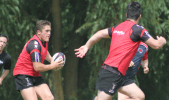 1:10
1:10
Three pass attack game
This exercise works on both attack & defence. The defenders have to cover the breakdown first and then work a drift defence while the attackers have to create space by fixing the first three defenders
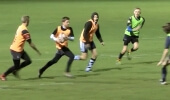 2:09
2:09
Attacking Fundamentals
If you're looking to build on your young players' ability to attack, we have loads of relevant ideas and examples. Here's a quick look. To see the full session, log in and go to the Northampton Saints page - 'Passing and Attacking Lines'
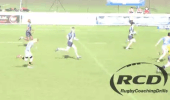 0:50
0:50
Stretch attack from re-start
Filton College claim the re-start and move the ball wide attack the space and stretch the defence. After recycling the ball quickly, they attack wide in the other direction where a 3 v 1 has been created.
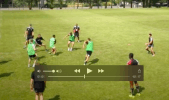 2:06
2:06
Attack Grid For All Ages
Progress your passing practises to make them competitive by adding defenders and ore chaos. This attack grid has lots of flexibility and can be used with players of all ages
Back Play - Attack From Scrum - Younger Youth
To take advantage of the forwards being grouped and to utilize the space this provides, young players should be encouraged to develop their decision making from a non-prescriptive environment.
It’s not a matter of going through a strike move repertoire. Its a matter of attacking the space between the two teams and running support lines that will assist the ball carrier
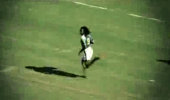 5:19
5:19
Sevens - Uncovered - Attack
Elite coaches discuss their attacking philosophies and this underpines the skills and techniques they will work on as coaches and the type of trainign sessions they will plan. As a coach how do you coach the skills that the Fijian players possess or the patience the Welsh side had to win the last 7's world cup. Does the team represent the ideas and plans of the coach?
 5:01
5:01
360 Games - Any Direction Attack
A warm up or starting 360 game where players can attack in any direction. This game is the basis to for coaches to then add numerous conditions based upon the focus of the session
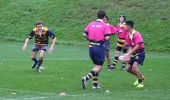 4:18
4:18
Attacking Lines: Unders and Overs
Using different angles of running confuses tacklers and pulls a defensive unit out of line. Learning the skills to both run these lines and pass the ball accurately is key to any ambitious team looking to attack and offload
 0:59
0:59
Broncos 7 - T-shape Attack
Broncos 7 - T-shape Attack
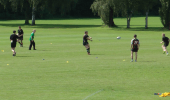 1:31
1:31
Turnover ball - Attacking from flat
This quick practice runs through how to attack straight from a turnover.
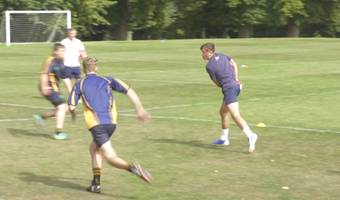 3:23
3:23
Attacking Shape - 4v1v1v1
This is the start of a series of progressions that takes you through how to set up your attacking shape through multiple lines of defence.
14. Attacking Waves Game
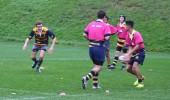 1:47
1:47
Running Lines in Attack
Modern defensive lines are well-organised and hard to break. It depends on the quality execution of attacking fundamentals. A good introduction is 'unders' and 'overs' running lines. Log in to see the full session.
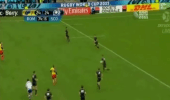 0:29
0:29
Men's - Counter Attack Plays
Not all kicks work out succesfully, in this clip the defenders turn a poor kick into a great counter attack
 0:33
0:33
Junior - Counter attack plays
Junior - Counter attack plays
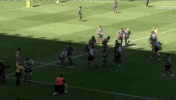 4:16
4:16
Lineout Attack
Here are some good examples of how to use the line out effectively in attack to help you in your coaching process
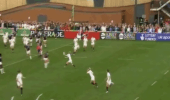 0:27
0:27
Women's - Counter attack plays 1
Women's - Counter attack plays
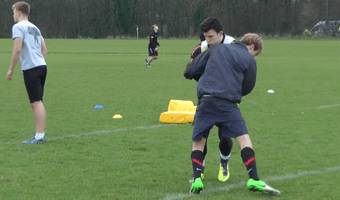 3:01
3:01
Continuity in Attack - Contact
Continuity in Attack - Contact
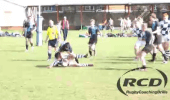 1:00
1:00
Support - Turnover and Counter-Attack
Support play is essential to rugby, particularly in sevens where there is more space. This clip sums up the importance of support. The Eastbourne College scrum-half is isolated and turned-over. Eton then counter-attack and, despite the best efforts of a single Eastbourne defender, they are able to secure the try thanks to an offload to a support runner.
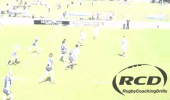 0:35
0:35
Counter-attack
After gaining a turnover, Filton College move the ball quickly in a counter-attack to secure a try.
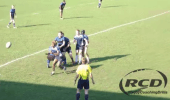 0:34
0:34
Attack from short lineout
With the dummy lifting pod moving back, Filton College execute a short lineout to the front lifter. They attack wide before 're-winding' and using the overlap on the nearside to break through for a try.
 0:49
0:49
Mike Catt - Attacking from Lineouts - Dummy Options
Classroom session with Mike Catt - discussing the key points of attacking from a lineout
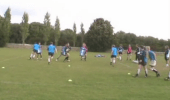 1:18
1:18
Diamond shape attack
Bath academy players practice the shape and lines of running for a "Diamond shape" attack system. The waves of players provide a number of different options
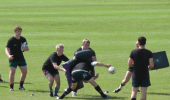 0:52
0:52
Attack from turnover
Attacking play from a turnover
 1:03
1:03
Mike Catt - Attacking from Lineouts - Quick Ball
Classroom session with Mike Catt - discussing the key points of attacking from a lineout
 1:00
1:00
Mike Catt - Attacking from Lineouts - Back Ball
Classroom session with Mike Catt - discussing the key points of attacking from a lineout
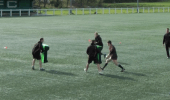 4:04
4:04
Developing running lines to attack
A series of progressions to develop how players attack when "Coming round the corner" from phase play
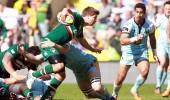 1:07
1:07
Ben Youngs Feature - Energy in Attack
Ben Youngs is a great example of a player who adds energy and pace to an attack through his efforts to produce quick ball for his backline, and his ability to catch defences off-guard. Log in to see coaching ideas from Leicester Tigers and other Aviva Premiership Rugby clubs.
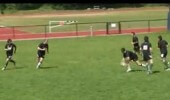 0:13
0:13
Attacking in waves of 3
The ability to realign quickly is important to developing the back play and counter attacking. Coaches can vary the numbers and timing of the first pass to make this exercise easier or more demanding. Key factors : Run straight - Comunicate early - Uniform distance and depth - Catch & pass in one movement - Hips straight - Hands & armes across the body - Realign quickly - Aerobic fitness
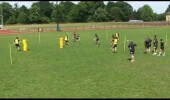 0:54
0:54
Change the point of attack - 4 v 3
This drill allows you to develop decision making by varying the attack and defence continually thus accelerating learning
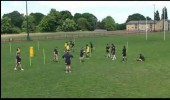 0:31
0:31
3v2 varied attack options
Developing decision making processes is essential to developing gamesense - in this drill we can vary the attack and defence to accelerate learning
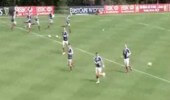 0:23
0:23
Lions 09 - Support & Attack
The ability to create attacking situations quickly is fundamental to creating pressure
Back Row Attack Support
Back Row Attack Support
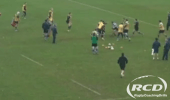 1:03
1:03
Fringe Attack - Pop and Ruck
Attacking close around the fringe can minimise risk of losing the ball and can help turn slow ball into quick ball, putting the defence on the back-foot.
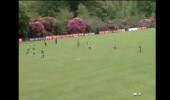
Lions 09 Attack plays 2
A clip on attacking options from the 2009 Lions
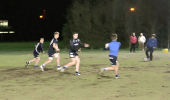 4:00
4:00
Attacking with simple systems
Sale Sharks full-back Rob Miller takes junior academy players through some attacking systems and highlights some of the key points to improve accuracy.
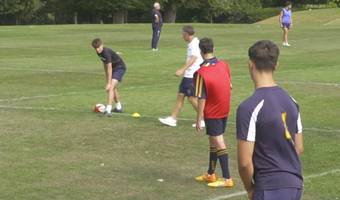 2:20
2:20
Attacking Shape - 4v2v2
While progressing your attacking shape be sure to include this exercise. With 2 waves of defence its crucial that your players learn to reload into a great shape in position.
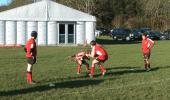 1:26
1:26
Live tacking in channel
Finally introduce live 1 v 1 tackling in a controlled environment using a channel. Standards will vary but as coaches it is important to praise all of the players. Doing this exercise too early may cause problems and refrain from doing so until the fundamental skills have mastered
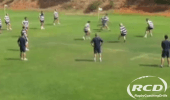 1:19
1:19
3 v 2 attacking practice
A useful drill to build decision-making skills. Attackers must choose from a variety of running and passing options.
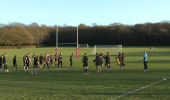 2:02
2:02
Broncos 3 - Develop waves of attack
The first wave of attackers identify space and punch through the first line of defence. The ball carrier looks to move the ball quickly and away from covering defenders. This exercise tries to copy game situations as players cover their team mates in defence
Continuity in Attack - Diamond Practice
The diamond practice can be the break out session of a whole part whole approach.
It is common when running such a practice for the attacking players to arrive at the tackle line having caught each other up. Depth should be maintained in order for the diamond shape to be fully effective.
The initial ball carrier needs to use footwork to move and disrtupt the defensive shape
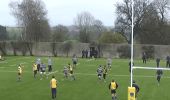 1:00
1:00
Attack Grid - 4 v 2
This continuous exercise puts pressure on your players to think fast and be ruthless in attacking the space. Coaches can change the size of the grid and the number of defenders to make it an easier game
 2:22
2:22
Restart Attack
Here are some examples of good use of the restart in attack to help you in your coaching process
Complimentary Attack
Complimentary Attack
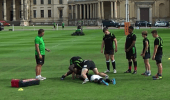 5:51
5:51
Turning defence into attack
The Northampton saints approach to defence is to "Turn over ball" and to this end the tackle is only the start of the process and the coach outlines this approach and provides some examples
8. Attacking a Drift Defence
QBE - Attacking a Condensed Defence
QBE - Back Line Attack From Set Piece
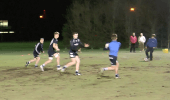 2:42
2:42
Attacking Options
Whether you're looking at fundamentals or strategy, we have loads of great examples and advice. Here's a small sample.
 2:21
2:21
An Attacking Style
Consistency throughout a team can be very important for its success. You can have several very talented players, but if they are all taking a different approach to the game, they are not likely to be successful. Top teams will determine their style of rugby and find the right players to play to that style.
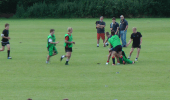 1:27
1:27
Turnover session - 1 Game to start
A full contact game, conditioned with channels on either side of the pitch. The attacking team must get the ball to both channels before they are allowed to score a try.
This is to spread the attack out, and create more opportunities for turnover ball to occur.
NB - Please ensure players have completed a full upper body warm-up before going into this full contact session.
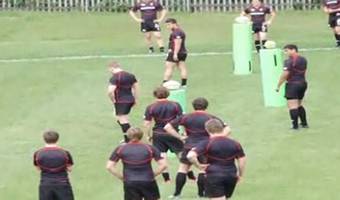 2:53
2:53
L2 - Conditioning Circuit
Using the full length of the pitch the practice is a continuous 3 v 2 scenario. • 3 attackers knock over a bag to collect a ball and attack 2 defenders in the 5m channel. • If they fail to beat the defenders (touch/grip), the attackers run back to knock over another bag and start again. • Having beaten the first defenders they carry on with the same ball to beat 2 further defenders who may choose a colour and start from the appropriate cone. • If the attackers fail to beat the defence they run back to the bag and start again with another ball. The defence can choose another colour to start from. • The next challenge is two free roaming defenders. If the attack fail they go back and knock over another bag to start again. • Finally the defenders choose a colour to start from and if the attack fail they get another ball and the defence choose another starting colour. • The objective is to complete the attack with the starting ball and restarts. Keep score to create competition
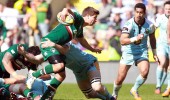
Ben Youngs - Energy in Attack
Ben Youngs
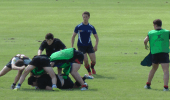 2:15
2:15
Turnover session - 2 Games
A full contact game, conditioned with channels on either side of the pitch. The attacking team must get the ball to both channels before they are allowed to score a try.
This is to spread the attack out, and create more opportunities for turnover ball to occur
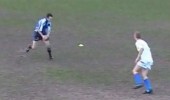
1 v 1 attack
Winger positional skills training.

Women's - Counter attack plays 2
Continuity in Attack - Tag Mini
Children have natural evaision skills. It is adults who teach children rugby players to run into obstacles

Sevens - Standard restart with attack winning ball 1
Continuity in Attack - The Game
What style of game would we wish to coach our young players to aspire to?
How can we set a coaching environment that encourages creativity in our players?

